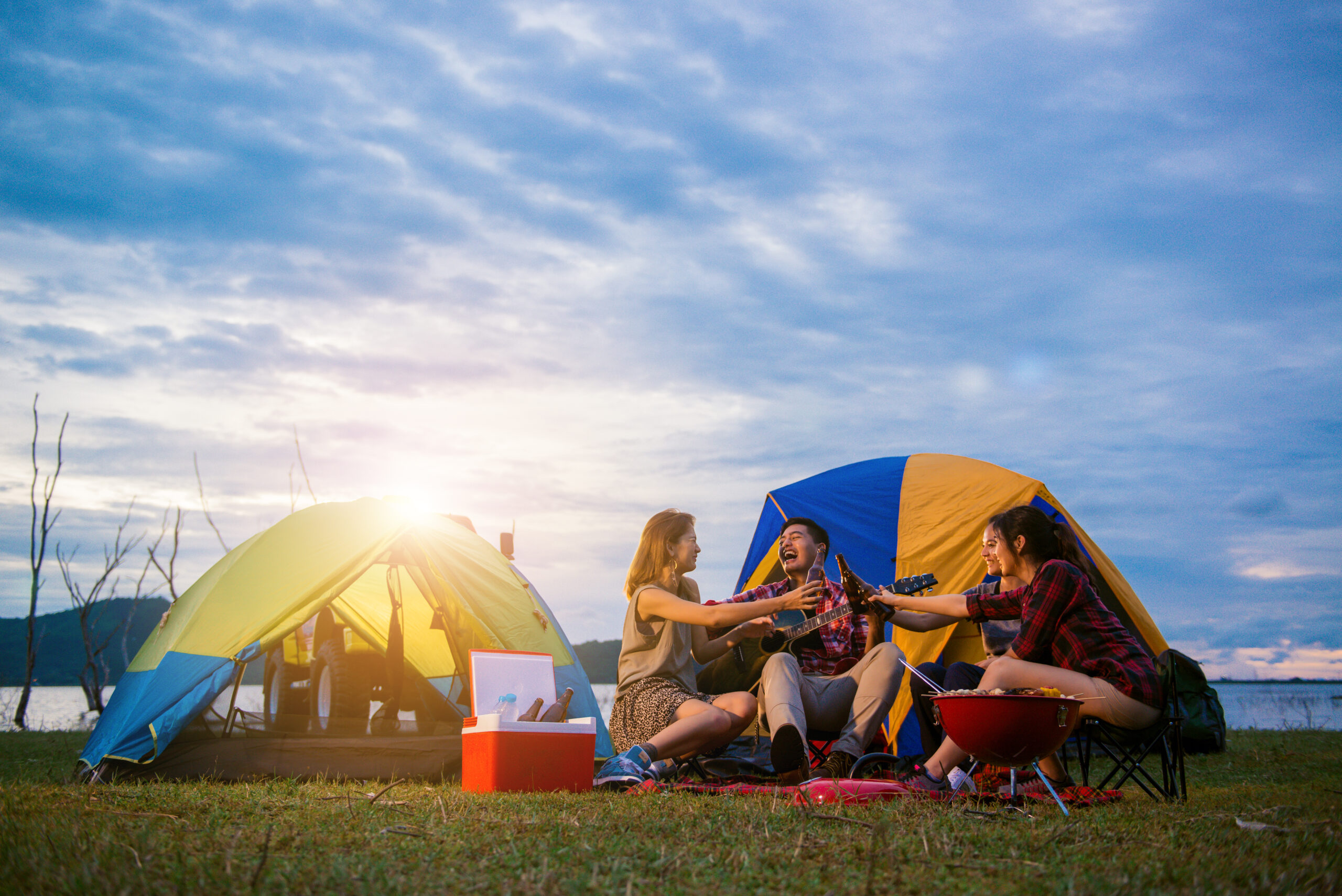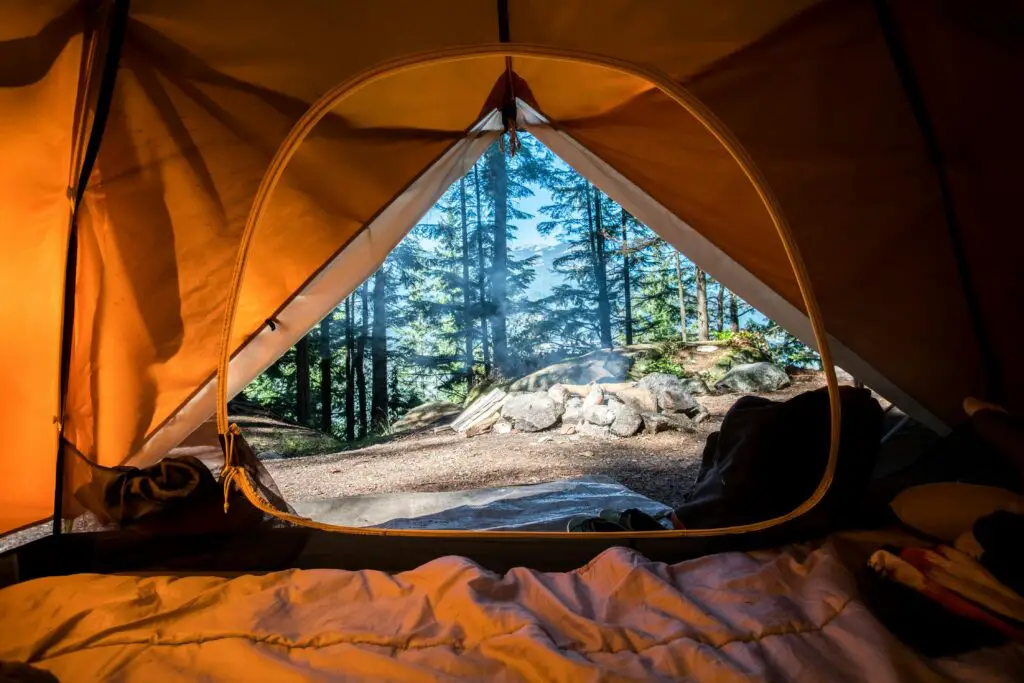This blog post may contain affiliate links. As an Amazon Associate I earn from qualifying purchases.
How to Stay Cool While Camping: Proven Tricks Most Campers Don’t Know
Picture this – you’re excited for a peaceful camping trip, but your tent feels more like a sauna than a cozy shelter. Staying cool while camping becomes quite the challenge when summer temperatures turn your tent into a miniature greenhouse. Trust me, I’ve spent countless nights tossing and turning in 90-degree weather, watching my relaxing outdoor adventure transform into an uncomfortable endurance test.
The good news? Years of camping have taught me some fantastic tricks to beat the heat. Did you know that climbing just 1,000 feet higher can drop the temperature by 3.5 degrees Fahrenheit? Pretty cool, right? From picking the perfect shady spot to simple tricks like taking down your tent during peak heat hours, I’ve gathered a collection of tried-and-true methods that really work. Stick with me, and I’ll share all my favorite cooling strategies – including some clever techniques that most campers never think to try.

Choosing the Perfect Campsite Location
Let me tell you – picking the right spot for your tent can make the difference between a sweaty, miserable night and a cool, comfortable camping experience. After hundreds of camping trips, I’ve learned exactly what to look for when choosing the perfect campsite.
Finding natural shade spots
Shade is your best friend when camping in hot weather. My favorite spots are always in forested campgrounds, especially those with tall, old-growth trees that create natural umbrellas above your tent. Setting up near water bodies like lakes or rivers helps keep temperatures down too. Just remember my golden rule – always pitch your tent at least 200 feet from water sources to stay safe from curious wildlife.
Understanding wind patterns
The breeze can be your cooling system if you know how to work with it. Here’s what years of camping have taught me about wind:
Avoiding heat-trapping terrain
Your campsite’s terrain plays a huge role in how hot or cool you’ll be. Here’s what really matters:
- Head for the hills – you’ll drop 3.5 degrees Fahrenheit for every 1,000 feet you climb
- Skip the valleys where cold air pools and hot air gets trapped
- Watch out for bowl-shaped areas that turn into natural ovens
Pro Tip: Before heading out, pull up Google Earth and check your campsite’s layout. This little trick helps me make sure my tent won’t bake in the afternoon sun.
My favorite setup? Face your tent southeast and stick to the western edge of any clearing. This way, morning sun dries off the dew, and you’ll catch plenty of afternoon shade from nearby trees.
One last thing – always check the typical temperatures for your camping spot before you go. Some places, like the California coast, stay a pleasant 70 degrees even when nearby spots hit a scorching 105.
Essential Cooling Gear for Campers
Let’s talk about gear that actually works! After countless sweaty nights in my tent, I’ve tested pretty much every cooling gadget out there. Here’s my tried-and-true list of equipment that’ll help you stay comfortable when the mercury rises.
Top portable fans for camping
You wouldn’t believe what a difference a good fan makes in your tent! My absolute favorite is the Geek Aire Rechargeable Outdoor High-Velocity Fan – this little powerhouse runs for 24 hours on a single charge. For something more versatile, I love the Odoland Portable LED Camping Lantern that doubles as an overhead fan.
Product Comparison Table:
| Feature | Geek Aire Fan | Odoland Lantern |
|---|---|---|
| Runtime | 24 hours | 12 hours |
| Charging Time | 3-4 hours | 6 hours |
| Water Resistance | Yes | No |
| Additional Features | Phone charging | Built-in light |
Cooling towels and their features
These aren’t your ordinary towels, folks! The Arctic Cool Instant Cooling Towel has this amazing HydroFreeze Technology that starts working the moment it gets wet. The science behind it is pretty neat – as the water evaporates, it pulls heat away from your skin.
Application Tips:
- Give it a good soak in water
- Squeeze out the extra water
- Pop it around your neck or wrists (works best here!)
- Just rewet when it starts feeling warm
Best camping mattresses for hot weather
Nothing ruins a camping trip faster than a sweaty, uncomfortable night’s sleep. The Therm-a-Rest MondoKing 3D has been my go-to mattress – its 4-inch thickness and fantastic ventilation keep me cool all night. If you’re watching your budget, check out the REI Co-op Camp Dreamer XL – it’s nearly as comfy but easier on the wallet.
Pro Tip: Here’s a trick I learned the hard way – always check for those moisture-wicking surfaces and air channels. They’re absolute game-changers on sticky summer nights!
You know what I love about camping gear? The right pieces working together can turn a hot, sticky tent into a surprisingly comfortable shelter. After years of testing different setups, I’ve found that combining a good portable fan, a couple of cooling towels, and a well-ventilated sleeping pad makes all the difference. Just remember – what works perfectly in Arizona’s dry heat might not be ideal for Florida’s humidity. Pick your gear thoughtfully, and you’ll be amazed at how comfortable summer camping can be!
Smart Tent Setup Techniques
Want to know the real secret to staying cool while camping? It’s all about how you set up your tent! After countless camping trips in every weather imaginable, I’ve figured out exactly how to create a cool oasis, even on those scorching summer days.
Optimal tent orientation
The direction your tent faces makes a huge difference in temperature regulation. Here’s what works best – point your tent entrance toward the breeze to catch that natural air conditioning. I love setting up near large rocks or hills because they create these amazing wind tunnels right into your tent door.
Pro Tip: Not sure about wind direction? Pack a small weathervane – it’s become one of my favorite tools for finding those steady breezes and getting my tent positioned just right.
Ventilation maximization tips
Getting good airflow through your tent is like an art form. Here’s what I’ve learned works best:
Rainfly Setup:
- Ditch the rainfly completely when there’s no rain in sight
- If storms might roll in, keep the fly up but create a gap between it and your tent
- Pull those guy lines tight to maximize the space between your rainfly and tent body
Mesh Usage:
- Open up every mesh panel you’ve got
- Leave those screens open all day long
- Think about adding an extra mesh inner tent – total game changer for airflow
Recommended Products:
You know what I love most about camping? There’s always something new to learn! After years of pitching tents in every imaginable spot, I’ve discovered that understanding wind patterns and ventilation isn’t just about comfort – it’s an art form. Get these basics right, and you’ll be amazed at how comfortable your tent can be, even when Mother Nature cranks up the heat.

Advanced Cooling Methods
Ready to take your camping comfort to the next level? After countless sweaty nights experimenting with different cooling setups, I’ve discovered some pretty clever tricks that most campers never try. Let me share my favorite advanced cooling methods that actually work.
DIY evaporative cooling system
Would you believe me if I told you that you could drop your tent’s temperature by 24 degrees Fahrenheit? Here’s my favorite DIY cooling setup that I’ve perfected over many camping trips:
Materials needed:
- 5-gallon bucket
- Computer fan
- Cooling pad
- Battery power source
Assembly steps:
- Drill holes in bucket sides
- Install cooling pad inside
- Mount fan on top
- Create water circulation system
Pro Tip: This little cooling machine works like magic in dry climates, but keep an eye on humidity levels – they can make or break its effectiveness.
Solar reflective techniques
Here’s something cool – proper reflection setup can block a whopping 97% of the sun’s heat. Let me break down what I’ve tried:
Product Comparison:
| Product | Effectiveness | Durability |
|---|---|---|
| Reflective Tarp | High | Medium |
| Solar Foil | Very High | Low |
| Thermal Blinds | Medium | High |
Night-time temperature management
The real secret to staying cool? It’s all about managing those nighttime temperatures. Here’s what works best for me:
- Trap that cool morning air by closing windows before sunrise
- Place damp towels near your tent openings – works like a charm!
- Set up those cross-ventilation paths just right
Final Thoughts – Staying Cool While Camping
You know what makes camping truly enjoyable? Being comfortable enough to actually appreciate those starlit skies and morning bird songs! After spending countless nights under canvas in every weather imaginable, I’ve learned that staying cool isn’t just about one magic solution – it’s about combining the right techniques.
Everything starts with picking that perfect spot. I can’t tell you how many times I’ve seen fellow campers struggle in a sunny valley while I’m enjoying a cool breeze up on a shaded ridge. Those natural elements – elevation, shade, and wind patterns – they’re your first line of defense against the heat.
The right gear makes a world of difference too. My Geek Aire fan has saved many sticky summer nights, and those Arctic Cool towels? Pure magic when the temperature soars! But it’s really about how you use everything together. Getting your tent orientation just right and managing ventilation can turn a potential sauna into a comfortable shelter.
Some of my favorite memories come from testing out those DIY cooling systems on extended summer trips. Sure, they take a bit more effort to set up, but watching fellow campers’ faces light up when they feel that cool breeze – totally worth it!
Here’s my best advice: start simple. Pick a good spot, bring some basic cooling gear, and get your tent setup right. Once you’re comfortable with these basics, try adding some of those advanced cooling tricks. The key is matching your cooling strategy to your camping style and location.
Remember though – staying cool shouldn’t come at the cost of safety. Keep that water bottle handy, watch those weather reports, and don’t be afraid to adjust your setup if things aren’t working. Trust me, with these techniques in your camping toolkit, you’ll be ready to enjoy the outdoors even when the mercury climbs!

